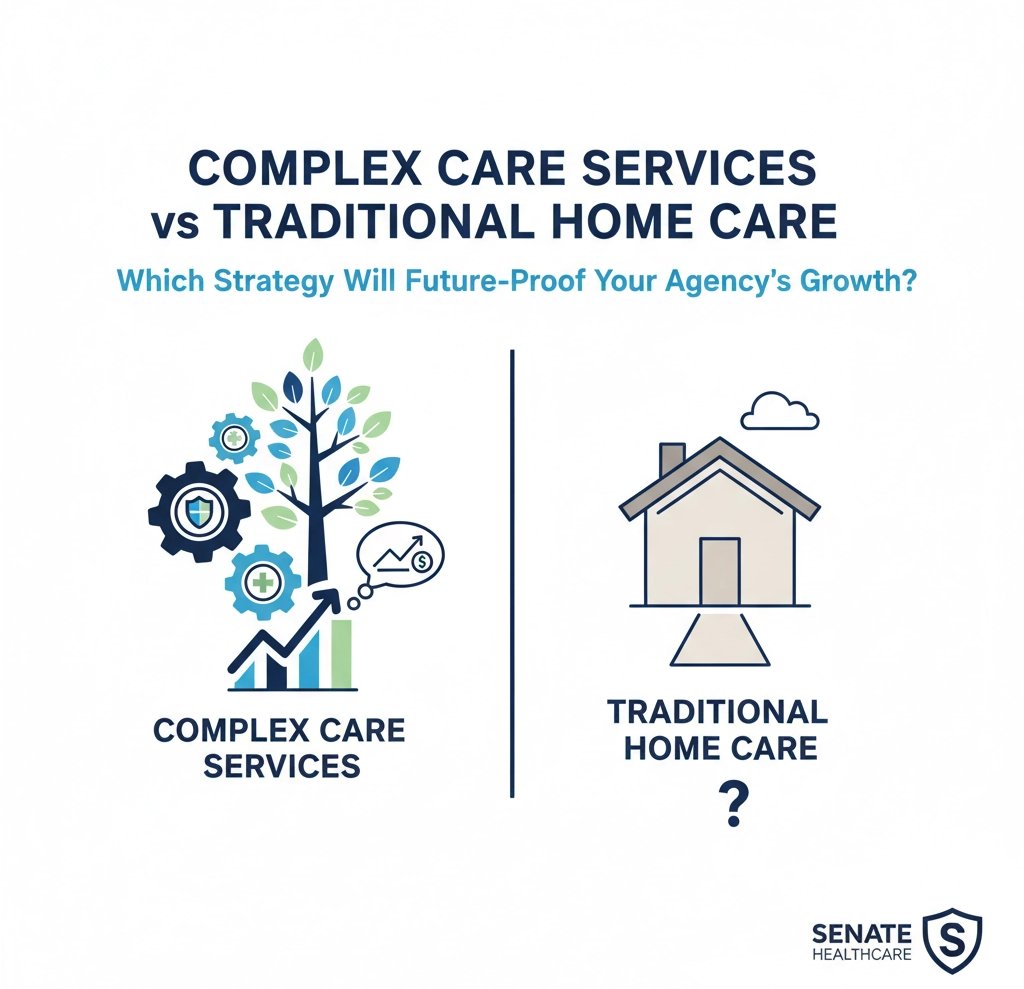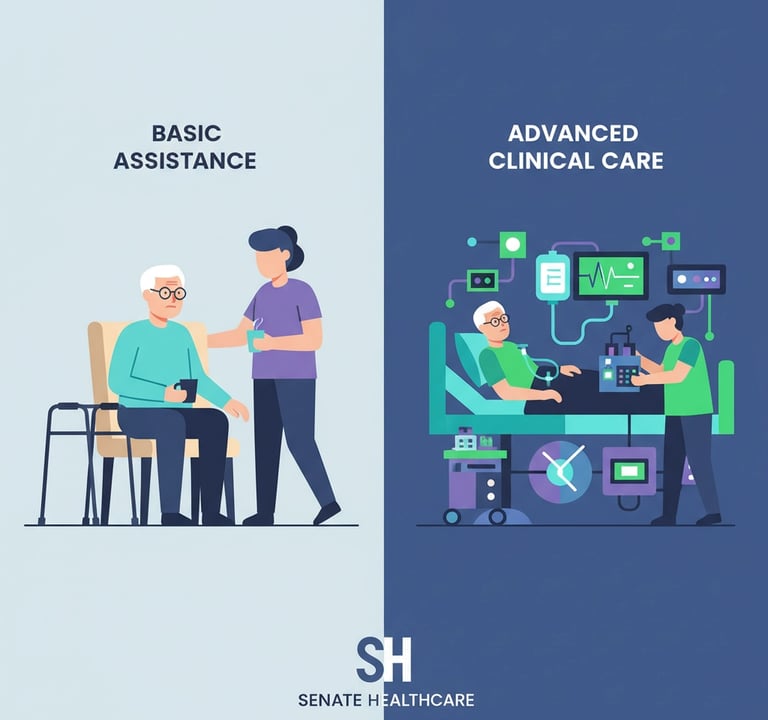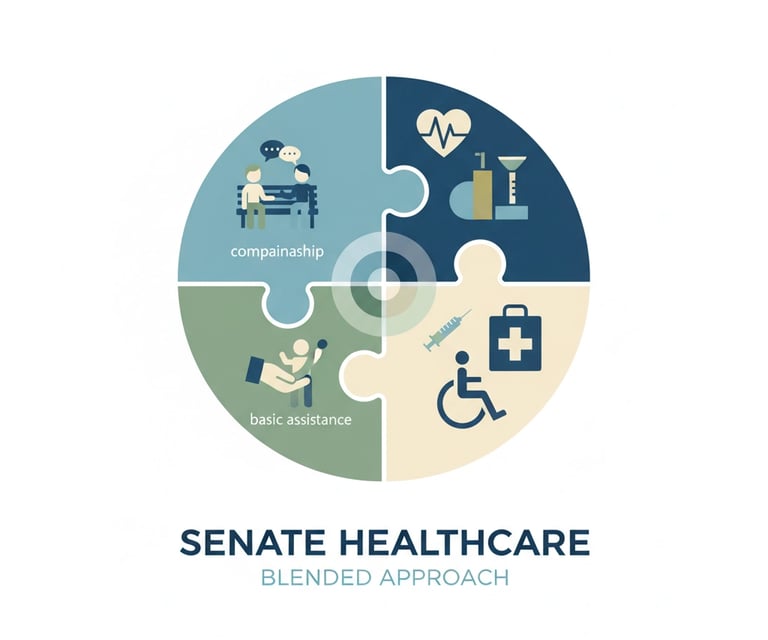Complex Care Services vs Traditional Home Care: Which Strategy Will Future-Proof Your Agency's Growth?
This comprehensive analysis examines the strategic choice between complex care services and traditional home care for agency growth. We explore market trends, operational requirements, and financial implications to help home health leaders make informed decisions about their service offerings. The post provides actionable insights for positioning agencies to capture the most lucrative growth opportunities through 2026 and beyond.
11/20/20256 min read


This post examines the strategic choice between expanding into complex care services versus maintaining traditional home care models for agency growth. We'll explore market trends, operational considerations, and provide actionable insights to help home health leaders make informed decisions about their service offerings for sustainable growth through 2026 and beyond.
The Healthcare Landscape is Shifting Dramatically
The home care industry stands at a critical inflection point. While traditional home care has served as the backbone of community-based services for decades, the market is rapidly evolving toward more complex, medically-intensive care delivery models. This shift isn't just a trend - it's a fundamental transformation driven by an aging population, earlier hospital discharges, and increasing patient acuity levels.
Home care agencies across the country are grappling with a strategic decision that will define their competitive position for years to come. The choice isn't simply about adding services; it's about positioning your agency to capture the most lucrative and sustainable growth opportunities in an increasingly competitive marketplace.
Understanding Complex Care Services
Complex care services represent a significant departure from traditional personal care assistance. These services encompass comprehensive medical support including skilled nursing visits, medication management, chronic disease monitoring, post-surgical care, and specialized therapies delivered in the patient's home environment.


The revenue potential for complex care services far exceeds traditional offerings. Agencies providing complex care typically command higher reimbursement rates and can establish longer-term client relationships. Additionally, these services position agencies as essential healthcare partners rather than commodity service providers.
Complex care also opens doors to lucrative partnership opportunities with hospitals, rehabilitation centers, and specialist physicians. These relationships create sustainable referral pipelines that traditional home care agencies often struggle to develop. The clinical expertise required for complex care naturally elevates an agency's reputation and credibility within the broader healthcare community.
However, the operational requirements are substantial. Staff must receive advanced training in clinical procedures, medication administration, and emergency protocols. Agencies need robust quality assurance programs, detailed care protocols, and often must navigate more complex regulatory requirements. The investment in infrastructure, training, and compliance can be significant.
Traditional Home Care: Strengths and Limitations
Traditional home care services focus on personal assistance, companionship, light housekeeping, and basic health monitoring. This model has proven successful for agencies serving clients with stable, lower-acuity needs who primarily require assistance with activities of daily living.
The operational simplicity of traditional home care remains its greatest strength. Staff training requirements are less intensive, regulatory compliance is more straightforward, and the business model is well-established. Many agencies have built profitable operations around traditional services with predictable costs and margins.


However, traditional home care faces increasing pressure from market forces. As healthcare continues its shift toward value-based care and population health management, payers are prioritizing services that demonstrate measurable health outcomes. Traditional home care, while valuable, often struggles to document the clinical impact that complex care services readily demonstrate.
The competitive landscape for traditional services has also become increasingly crowded. With lower barriers to entry, new agencies regularly enter the traditional home care market, driving down prices and making differentiation challenging. This commoditization threatens long-term profitability and growth potential.
Market Trends Favoring Complex Care
Several converging trends are accelerating demand for complex care services. The "hospital at home" movement continues gaining momentum, with recent legislative proposals extending these programs through 2030. This creates substantial opportunities for agencies equipped to provide intensive home-based medical care.
The aging baby boomer population is driving demand for specialized services including dementia care, chronic disease management, and post-acute recovery support. These patients typically require more sophisticated care coordination and clinical oversight than traditional home care provides.
Medicare Advantage plans are increasingly seeking partners who can demonstrate improved patient outcomes while reducing overall healthcare costs. Complex care providers are well-positioned to meet these value-based care requirements through their clinical capabilities and outcome measurement systems.


Strategic Considerations for Agency Leaders
The decision between complex care expansion and traditional service focus involves several critical factors. Financial capacity represents the most immediate consideration. Complex care expansion requires significant upfront investment in staff training, clinical infrastructure, and compliance systems. Agencies must honestly assess their ability to fund this transition while maintaining operational stability.
Market positioning also plays a crucial role. Agencies in markets with limited complex care providers may find significant competitive advantages in expansion. Conversely, agencies in saturated markets might benefit from specializing in underserved traditional care niches.
Staff capabilities and retention present another key factor. Complex care requires recruiting and retaining clinically skilled staff, often at higher compensation levels. Agencies must evaluate their ability to attract qualified personnel and maintain appropriate staff-to-patient ratios for complex cases.
The Blended Approach: Maximizing Growth Opportunities
Many successful agencies are adopting hybrid models that combine traditional and complex care services. This approach allows agencies to serve diverse patient populations while building complex care capabilities gradually. Clients can transition between service levels as their needs change, creating longer-term relationships and higher lifetime value.
A blended model also provides revenue diversification, reducing dependence on any single service line or payer source. Agencies can maintain stable traditional care revenue while developing higher-margin complex care services. This strategy offers financial stability during the transition period while building capabilities for future growth.


Implementation of a blended approach requires careful planning and phased execution. Agencies might begin by adding specific complex care specialties such as post-surgical care or diabetes management before expanding to comprehensive complex services. This gradual approach allows for staff development, system refinement, and market validation without overwhelming operational capacity.
Technology and Complex Care Delivery
Technology integration becomes essential for agencies pursuing complex care expansion. Remote patient monitoring, telehealth platforms, and electronic health records enable efficient delivery of sophisticated care services while maintaining cost-effectiveness.
These technological capabilities also support the clinical documentation and outcome measurement required for value-based care contracts. Agencies can demonstrate improved patient outcomes, reduced hospitalizations, and enhanced care coordination through robust data collection and analysis.
The investment in healthcare technology platforms positions agencies for future growth opportunities as the industry continues embracing digital health solutions. Early adoption provides competitive advantages and operational efficiencies that support sustainable expansion.
Regulatory and Compliance Implications
Complex care services operate under more stringent regulatory oversight than traditional home care. Agencies must navigate state licensing requirements, Medicare and Medicaid compliance standards, and specialized accreditation processes. This regulatory complexity requires dedicated compliance resources and ongoing investment in training and system updates.
However, regulatory compliance also creates barriers to entry that protect established complex care providers. Agencies that successfully navigate compliance requirements gain competitive moats that traditional service providers cannot easily replicate. The regulatory investment becomes a strategic asset that supports long-term market positioning.


Financial Analysis and ROI Considerations
While complex care requires higher upfront investment, the financial returns typically justify the expenditure. Complex care services command premium pricing, establish longer client relationships, and create opportunities for additional service expansion. The higher acuity and clinical requirements translate to improved margins compared to traditional services.
Traditional home care, while requiring lower initial investment, faces ongoing pressure on margins due to increased competition and commoditization. The growth potential remains limited, and agencies may struggle to achieve the scale necessary for long-term sustainability.
For agencies considering succession planning, complex care capabilities significantly enhance valuation multiples. Acquirers place premium values on agencies with diversified service offerings, clinical capabilities, and established healthcare partnerships that complex care providers typically develop.
Making the Strategic Decision
The choice between complex care expansion and traditional service focus ultimately depends on individual agency circumstances, market conditions, and leadership capabilities. However, agencies that fail to address changing market demands risk gradual obsolescence as healthcare continues evolving toward more integrated, outcome-focused care delivery models.
Agencies should conduct comprehensive market analysis, assess their financial and operational capabilities, and develop detailed implementation plans before making strategic commitments. Professional guidance from healthcare consultants and industry experts can provide valuable insights and help avoid costly implementation mistakes.
The healthcare industry's trajectory clearly favors providers who can deliver measurable clinical outcomes while maintaining cost-effectiveness. Agencies positioned to meet these evolving requirements through complex care capabilities will capture the most attractive growth opportunities in the years ahead.
Conclusion
The future belongs to home care agencies that can adapt to changing market demands while maintaining operational excellence. Complex care services represent the highest-growth opportunity in the industry, but successful expansion requires careful planning, adequate investment, and sustained commitment to clinical excellence.
Agencies choosing to focus exclusively on traditional services must acknowledge the limited growth potential and increasing competitive pressure this strategy entails. While viable in certain market niches, traditional-only approaches face long-term sustainability challenges as the industry continues its evolution toward more sophisticated care delivery models.
The most successful agencies will likely adopt hybrid approaches that leverage existing capabilities while building complex care competencies over time. This strategy provides financial stability during transition periods while positioning agencies for sustainable growth in an increasingly competitive and regulated marketplace.
Resources:
https://claimonthealth.co.uk/blog/home-vs-residential-complex-care/
https://www.accucare.com/2025/03/14/private-in-home-health-care-vs-traditional-care/
https://pulivarthigroup.com/the-shift-to-complex-care-in-home-health-services/
https://advancedcarepartners.com/home-health-care-vs-nursing-homes-whats-right-for-you/
https://aaniie.com/news/how-home-care-agencies-can-prepare-now-to-secure-a-strong-start-in-2025/
https://jamanetwork.com/journals/jama-health-forum/fullarticle/2815745
Unlock Your 30-Minute Agency Succession Review
Maybe you're ready to expand your reach, or perhaps it's time to consider your legacy and the future of your business. Either way, it all begins with a conversation. Schedule a confidential, no-obligation call to explore what the future might hold for you and your business.
Complete the form, and we'll reach out for a chat...


© 2025 SENATE HEALTHCARE LLC.
ALL RIGHTS RESERVED


